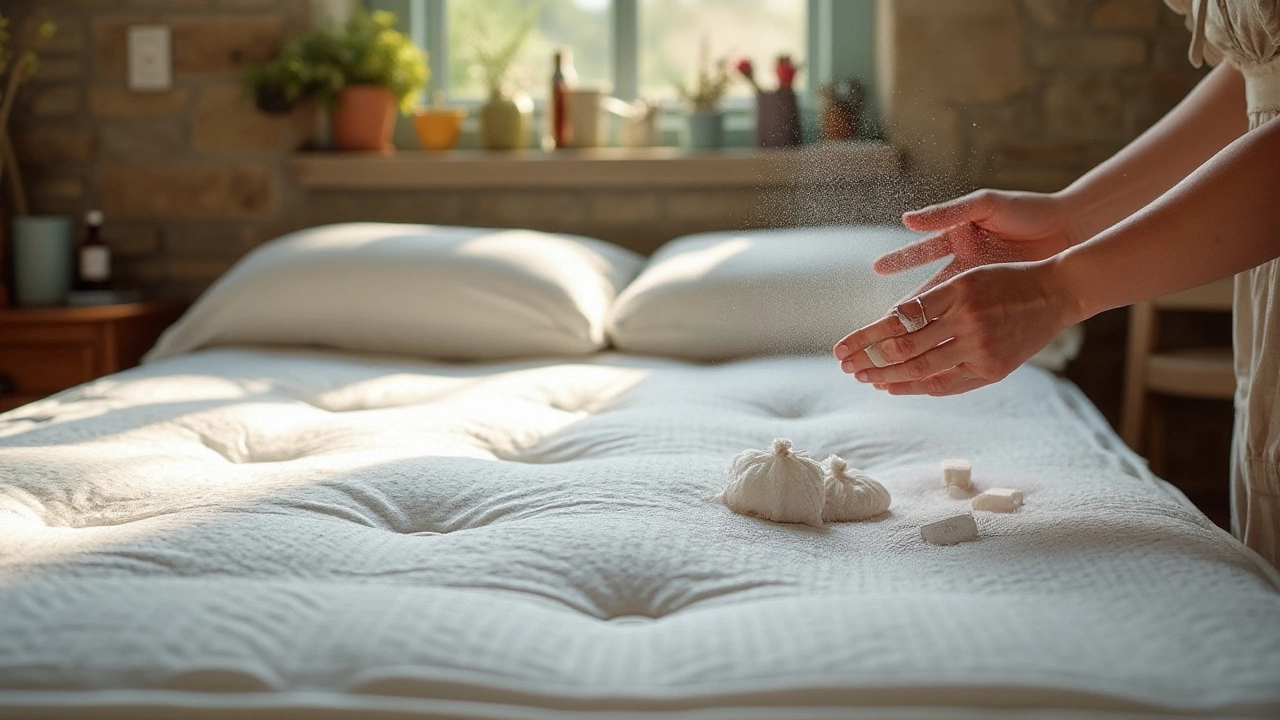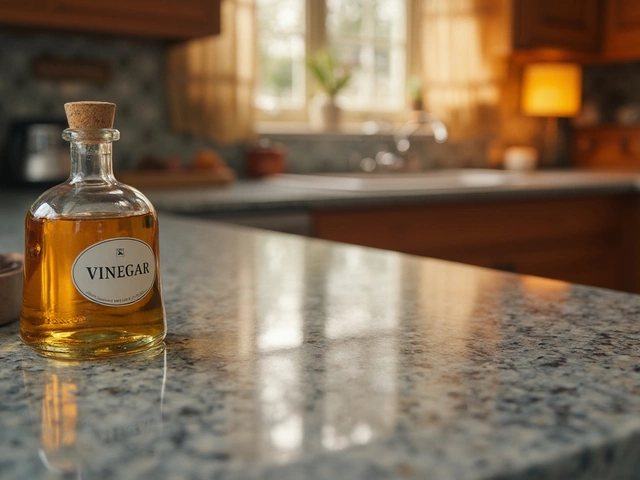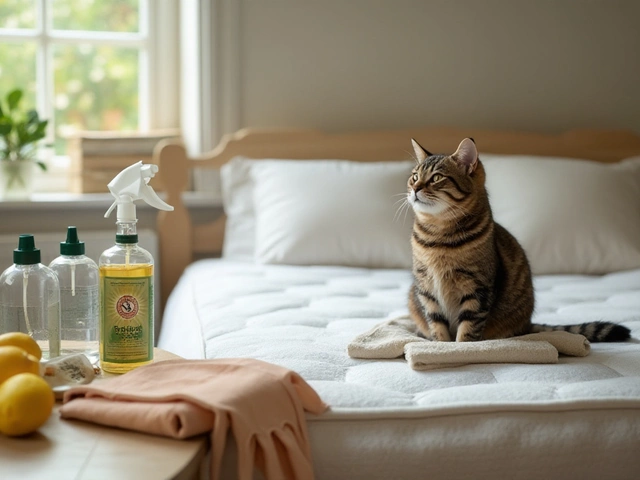A mattress is more than just a cornerstone of good sleep; it's a crucial element of our daily comfort. However, over time, it's common for mattresses to collect dirt, sweat stains, and other pesky pollutants, leaving them in need of a thorough cleaning. Whether it's a spilled drink, a pet's mishap, or just accumulated dust, a grimy mattress can be addressed with the right approaches and techniques.
In this guide, we'll unravel the mysteries of mattress material and present methods to tackle various stains and odors. We'll also delve into both traditional and natural cleaning practices, ensuring you have a clean, fresh surface for your nighttime respite. After all, a clean mattress is a step toward sound, healthy sleep. So roll up your sleeves, and let's dive into the world of mattress rejuvenation with ease and efficiency!
- Understanding Mattress Material
- Common Causes of Mattress Dirtiness
- Basic Mattress Cleaning Tools
- Natural Cleaning Solutions
- Step-by-Step Mattress Cleaning Guide
- Maintaining a Clean Mattress
Understanding Mattress Material
When it comes to keeping your sleeping area spotless, knowing the type of mattress you're dealing with can make all the difference in your approach. Every mattress has its own unique properties, and understanding these can help you tailor your cleaning strategy for the best results. Let's begin with innerspring mattresses, the stalwarts of bed design for decades. These are generally constructed with a network of metal coils that provide support. The layers above these coils can vary greatly in substance and thickness, comprising materials such as foam, polyester, and even cotton batting, each with its own care requirements. Innerspring mattresses benefit from regular vacuum cleaning to keep dust at bay, followed by steam cleaning for deeper sanitation.
If your mattress is made of memory foam, you're sleeping on something derived from NASA technology. These mattresses are excellent at contouring to your body, reducing pressure points and enhancing comfort. However, their dense nature means they can be a bit more challenging to clean. It's essential to avoid soaking them, as moisture seeping into the core can lead to mold and odors. Spot cleaning with gentle detergent and ensuring thorough drying is crucial. As noted by the Sleep Foundation, "Caring for your memory foam mattress keeps it in excellent condition for years and maintains its comfort."
Latex mattresses, often favored for their eco-friendly, hypoallergenic nature, offer a different kind of sleep experience. Composed from either natural or synthetic latex, these mattresses are inherently resistant to dust mites and mold. Regular surface cleaning should suffice to maintain them, with occasional mild soap solutions for stain removal. Unlike memory foam, they can handle a bit more moisture, but it's still advisable to avoid complete saturation. For those with latex allergies, special covers can help keep reactions at bay while enjoying the benefits of a latex mattress.
Those opting for a hybrid mattress enjoy a blend of memory foam or latex layers atop innerspring coils, combining the benefits of both to offer a balanced support and comfort experience. Maintain these with a mixture of the techniques used for both traditional innerspring and foam—frequent vacuuming, gentle spot cleaning, and occasional steam treatments without exposing the whole mattress to excessive moisture.
Finally, we'll touch on airbeds, often equipped with adjustable air chambers for customizable firmness. While these are often used for temporary sleeping arrangements, some models are designed for regular use. The surfaces of these beds can be cleaned like any standard mattress, though special attention should be paid to the air chamber components—ensuring connections remain secure and inspecting for any slow leaks.
Understanding your mattress material doesn't just make for a fresher, longer-lasting bed; it also lays the groundwork for informed, effective cleaning. Each of these mattress types interacts with dirt and moisture differently, and adapting your approach accordingly ensures you're providing the best care possible. Whether dealing with dust, sweat, or even the special challenges posed by pets or young children, knowing what your mattress is made of is your first step toward a cleaner, healthier haven for sleep.
Common Causes of Mattress Dirtiness
Many people don’t realize how quickly a mattress can become dirty. It's often a case of 'out of sight, out of mind,' until a dreaded spill or the sneaky arrival of bed bugs triggers the alarm. One of the primary culprits contributing to mattress filth is the natural shedding of human skin. Our bodies perpetually shed skin cells, which, unbeknownst to some, accumulate in our bedding over time. These cells serve as a feast for dust mites, microscopic critters that thrive in warm and humid environments. Their presence is not only unsettling but can exacerbate allergies, disrupting your rest with sneezes and sniffles.
Beyond these organic contributors, sweat and body oils play significant roles in soiling a mattress. Often, during warmer nights or if your room lacks adequate ventilation, you'll release perspiration while sleeping. This moisture can seep into the mattress, not only discolouring it but also becoming a breeding ground for mould and mildew if neglected. Adding to this, our bodies naturally produce oils that rub off onto the mattress when we sleep, leading to yellowish stains that are hard to erase. Mishaps from pets and young children are other frequent sources of mattress grime. Accidental spills, be it a cup of tea or a toddler's juice, leave stark stains if not promptly addressed. Plus, pets might track in dirt or, in unfortunate cases, have accidents that require urgent attention.
Stains and Odors
Married to the battle against dirt are the unappealing stains and odors that make their mark. Many stains, like those from coffee or red wine, have a notorious reputation for being stubborn. Similarly, pungent odors from sweat or spills, given time, become entrenched in the mattress fibers. These odors may not be noticeable immediately, but during times of increased humidity, they can intensify, leading to discomfort. It's crucial to address spills and stains immediately to prevent them from setting and becoming permanent.The frequency of cleaning can also impact the degree of dirtiness your mattress encounters. With the fast-paced hustle and bustle of modern living, many individuals fall into a pattern of neglect, prioritizing other chores over cleaning their sleeping spaces. This neglect often allows dirt, allergens, and debris to settle deeply, becoming tougher to extract with each passing day.
As the Royal Society for Public Health emphasizes, "The average person spends a third of their life in bed, so being vigilant about the cleanliness of our sleeping environments is not just a matter of routine hygiene; it's a significant booster of our well-being." When we connect the dots, it's clear that the common causes of mattress dirtiness are far from simple. From tiny dust mites making a home in your bed to the more visible culprits like food and drink spills, our beloved mattresses endure quite the challenge. Recognizing these causes gives us the power to combat them effectively, ensuring our mattresses remain clean, comfortable, and conducive to restful sleep.
Basic Mattress Cleaning Tools
When it comes to tackling a really dirty mattress, equipping yourself with the right set of tools is key. Just as an artist needs the right brushes and a carpenter the right saws, a successful cleaning venture hinges on having the correct gadgets and materials. With a collection of practical, effective tools at your disposal, the task of removing stains and odors from your mattress becomes significantly less daunting.
One indispensable item is a reliable vacuum cleaner, ideally equipped with an upholstery attachment. This helps in the removal of loose dirt, dust mites, and other allergens that may be dwelling in the crevices of your mattress. A thorough vacuuming not only keeps your sleeping environment hygienic but also prolongs the lifespan of your mattress. Additionally, for those stubborn spots that resist your initial cleaning efforts, a handheld vacuum with added suction power can be invaluable.
"A clean mattress is essential for good health," says Dr. Matthew Jones, a leading sleep researcher. "Regular cleaning can significantly reduce allergen exposure and improve sleep quality."
Moving from dry to liquid, another essential tool in your mattress cleaning arsenal is a high-quality stain remover. Choosing a cleaning solution that’s specially formulated for fabric and upholstery can make a world of difference when confronting particularly stubborn stains like coffee, wine, or even pet accidents. These solutions are designed to break down stains at a molecular level, ensuring that your mattress not only looks cleaner but is also genuinely free from dirt.
Next, consider the role of enzymatic cleaners. They are a secret weapon against organic stains such as urine or sweat, owing to their ability to naturally break down proteins that cause stains and odors. Using an enzymatic cleaner can also help in preventing discoloration and maintaining the aesthetic appeal of your mattress over time. Complement these agents with a soft scrubbing brush to gently but effectively work the cleaner into the fabric.
| Tool | Purpose |
|---|---|
| Vacuum Cleaner with Upholstery Attachment | Removes dirt and allergens |
| Stain Remover | Tackles stubborn stains |
| Enzymatic Cleaner | Breaks down organic stains |
Lastly, having a few clean microfiber cloths on hand is always beneficial. They are gentle enough to prevent fabric damage yet effective in wiping away moisture and cleaning residues. Microfiber's ability to attract and lock in dirt particles reduces the risk of simply moving the grime around, ensuring a more thorough clean. Combine that with a good spray bottle filled with water, and you've got a complete toolkit for spritzing areas that need more attention before wiping them down.
With these cleaning tools, you are well-prepared to rejuvenate your mattress and restore it to its former glory. Regular upkeep with the right equipment not only enhances cleanliness but also contributes to a more comfortable, healthier sleep environment. It's not just about having the tools, but knowing how to use them to extend the life and quality of your cherished mattress.

Natural Cleaning Solutions
When it comes to tackling a really dirty mattress, you might wonder if there's a way to do it without using heavy chemicals or expensive cleaning products. Happily, nature has provided us with some powerful, yet gentle, alternatives that are perfect for this very challenge. Household staples like baking soda, white vinegar, and essential oils can work wonders on spots and smells, proving a green approach to mattress cleaning can be just as effective as traditional methods. The process begins with understanding the specific needs of your mattress and the type of grime you're dealing with. It's important to ensure you select natural remedies that target dirt and stains while keeping the integrity of the material intact. Let's start by looking at some of these natural heroes found right in your pantry.
Essential household ingredients like baking soda have long been revered for their ability to neutralize odors, making them a staple in-home cleaning kits. In fact, baking soda acts as a wonderful drying agent, capable of absorbing moisture and eliminating smells when sprinkled liberally over your mattress. Let it sit for at least 30 minutes (but preferably longer) to draw out odors deeply embedded within the layers. You can vacuum it up afterward to leave your mattress smelling terribly fresh. If weighty stains are plaguing the surface of your mattress, create a paste with baking soda and water, gently applying it to the affected areas, which will loosen up the grime without soaking the fabric. This very approach was echoed by cleaning expert Jolie Kerr, who says, "Baking soda is a naturally effective cleanser and deodorizer, making it indispensable in maintaining home hygiene."
Adding white vinegar to your cleaning arsenal can bolster your stain-fighting capabilities, offering both sterilization and deodorizing effects. By mixing equal parts vinegar and water in a spray bottle, you'll craft a potent yet gentle solution for a truly deep clean. Lightly mist the surface and resist the urge to over-saturate the mattress, as too much moisture can foster mold growth. After applying vinegar, let the mattress air dry completely before putting the bed back together. You may want to test an inconspicuous patch first to ensure there's no reaction with the fabric.
Lemon and Lavender: The Dynamic Duo
Beyond baking soda and vinegar, another natural remedy worth recognizing includes a combination of lemon juice and lavender oil, known for their fresh scent and germ-fighting properties. Lemon juice can help bleach out pesky stains, while the soothing aroma of lavender oil not only deters dust mites but also promotes restful sleep. Create your custom cleaning concoction by mixing two tablespoons of lemon juice with ten drops of lavender oil in a cup of water, then apply with a clean cloth for a refreshing finish. This naturally aromatic solution can satisfy both your cleaning needs and desire for a tranquil bedroom atmosphere.
These strong, yet gentle, natural cleaning solutions for your mattress provide both cleanliness and peace of mind without the reliance on harsh synthetic products. By incorporating these techniques into your regular care routine, you can maintain a clean, fresh, and sustainable sleeping environment for years to come. If you're interested in knowing how these green techniques compare to commercial products in terms of effectiveness, consider reviewing studies that reveal the percentage of germs natural cleaners can target compared to chemical counterparts. Choosing organic options reflects a commitment not only to personal health but also to our lovely planet.
Step-by-Step Mattress Cleaning Guide
Getting your mattress cleaning routine down to a science doesn't have to be an overwhelming task, even when confronting a mattress that's seen better days. The goal is to break it into manageable steps, addressing both surface dirt and hidden dust mites that could be wreaking havoc on your allergy symptoms. Start by stripping your bed of all its layers—sheets, pillowcases, and protectors—and give them a good wash. Hot water is preferable as it can help eliminate allergens. Meanwhile, let's focus on the more stubborn culprit, your mattress itself.
Before you dive in with cleaning tools, it's worth taking a moment to vacuum the mattress—yes, a vacuum cleaner is not just for carpets but for your bed as well. Using an upholstery attachment, painstakingly run it over the entire surface of the mattress. Pay particular attention to seams and crevices where dust and skin cells love to congregate. It might surprise you to learn how much debris can gather over time, unseen and overshadowed by more obvious stains. By regularly vacuuming, you can prevent unwanted accumulations and give your mattress a longer lifespan.
When it comes time to remedy those various stain removal tasks that every mattress seems to acquire, the options for solutions vary from store-bought upholstery cleaners to homemade mixtures. If you prefer a DIY approach, concoct a solution using equal parts water and white vinegar. White vinegar is not only a potent cleaner but also a natural deodorant that can dispel the scents that have absorbed into the fabric. Lightly spray the solution onto the stained areas and let it sit for a few minutes to penetrate. Rubbing too hard is to be avoided, as it might only work the stain deeper into the fibers.
Deep Cleaning with Baking Soda
Among the magic tools in deep cleaning your mattress, baking soda stands out for its versatility and effectiveness. Once you’ve dealt with immediate stains, consider pouring a generous amount directly onto the mattress surface. This might look excessive, but baking soda works wonders not only on stains but also on odors by absorbing moisture and neutralizing smells. Let it sit for at least 30 minutes, though leaving it for a couple of hours should yield even better results, allowing time for it to extract any embedded oils and smells.
"No one wants to slip between sheets on a bed that hasn't been cleaned in months," says Jane McCarthy, a renowned cleaning expert. "Regular maintenance and proper cleaning techniques extend the life and comfort of your mattress."
After giving the baking soda ample time to do its job, grab your vacuum again to remove the powder along with any residue that's been drawn out. Carefully vacuum the baking soda without missing any nooks, transforming your mattress into a refreshed version of itself. Post-cleaning, consider using a fabric refresher spray, lightly misting the surface to add a layer of pleasant aroma that will greet you when you next cocoon into bed. This step isn't strictly necessary but adds an element of luxury.
Regular Mattress Maintenance
| Maintenance Task | Frequency |
|---|---|
| Rotate Mattress | Every 3 months |
| Vacuum Surface | Monthly |
| Spot Cleaning | As Needed |
To finish, it’s prudent to engage in regular maintenance practices to keep your mattress sanitized and inviting. Frequently rotating your mattress—head to foot—promotes even wear, preventing sagging. Strive to vacuum monthly and tackle any emerging stains immediately, staving off the build-up that makes cleaning overly demanding. After all, maintaining a hygienic rest space isn't just about cleaning away the grit but also about preserving the comfort and aesthetics of your mattress for years to come.
Maintaining a Clean Mattress
Keeping your mattress in pristine condition is both an art and a habit. Regularly cleaning and maintaining your mattress not only prolongs its lifespan but also ensures a healthier sleeping environment. The first tip is to always use a mattress protector. These protectors act as an essential barrier against spills, stains, and dust mites, making it much easier to maintain a clean surface. Opt for a waterproof and breathable version to keep sweat and body oils from seeping into the mattress.
Routine vacuuming every month can also do wonders. A vacuum cleaner with a HEPA filter can remove accumulated dust, skin flakes, and even dust mites. For best results, use the upholstery attachment to vacuum the entire surface of the mattress, paying attention to crevices and seams. Another smart trick is rotation. Rotating your mattress every three to six months helps distribute the wear evenly and can prevent sagging, especially with spring mattresses.
Laundering your bed linens and pillowcases weekly is another non-negotiable habit for maintaining a spotless mattress. This frequent wash reduces dirt transfer, minimizing the likelihood of bacteria and allergens making their way onto the mattress. Additionally, airing out the mattress can help keep odors at bay. By simply opening a window and letting the mattress breathe, you're allowing fresh air to circulate, which can eliminate unwanted smells.
“The best way to keep your mattress fresh is consistent upkeep, alongside a good quality protector. This proactive approach keeps disruptive cleaning at arm's length.” – Sleep Foundation Expert
For those who are inclined towards natural fresheners, a simple mix of baking soda and essential oils can be your ally. Sprinkling some of this blend on the mattress and letting it sit for a few hours before vacuuming it off can leave your mattress smelling clean and inviting. Popular oils include lavender and eucalyptus for their soothing and antibacterial properties, respectively.
And don’t forget about those cozy-but-cluttered bedrooms. Clutter can trap dust, so keep the space around your mattress tidy and free from unnecessary objects. Minimal decor and clean spaces not only enhance relaxation but also contribute to a cleaner mattress area. Surprisingly, sunlight can be an unexpected boon in maintaining your mattress. Occasionally placing your mattress in direct sunlight can eliminate mildew and bacteria through natural UV rays.
Remember, maintaining a clean mattress isn't just about aesthetics. It contributes greatly to sleep quality and general health. A well-kept mattress ensures you start and end each day wrapped in cleanliness and comfort. So establish these habits, and the benefits will ripple through every facet of your nightly routine, supporting a refreshing slumber and a healthier lifestyle.




